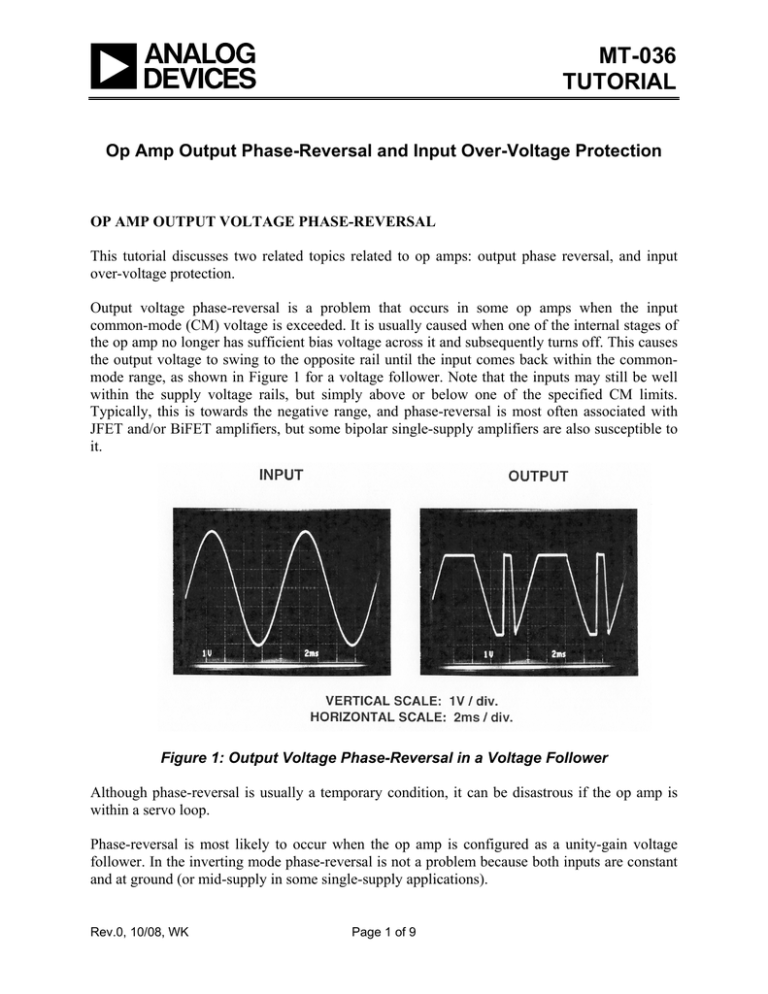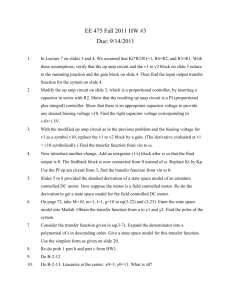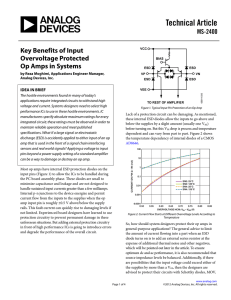MT-036 TUTORIAL Op Amp Output Phase-Reversal and Input Over-Voltage Protection
advertisement

MT-036 TUTORIAL Op Amp Output Phase-Reversal and Input Over-Voltage Protection OP AMP OUTPUT VOLTAGE PHASE-REVERSAL This tutorial discusses two related topics related to op amps: output phase reversal, and input over-voltage protection. Output voltage phase-reversal is a problem that occurs in some op amps when the input common-mode (CM) voltage is exceeded. It is usually caused when one of the internal stages of the op amp no longer has sufficient bias voltage across it and subsequently turns off. This causes the output voltage to swing to the opposite rail until the input comes back within the commonmode range, as shown in Figure 1 for a voltage follower. Note that the inputs may still be well within the supply voltage rails, but simply above or below one of the specified CM limits. Typically, this is towards the negative range, and phase-reversal is most often associated with JFET and/or BiFET amplifiers, but some bipolar single-supply amplifiers are also susceptible to it. Figure 1: Output Voltage Phase-Reversal in a Voltage Follower Although phase-reversal is usually a temporary condition, it can be disastrous if the op amp is within a servo loop. Phase-reversal is most likely to occur when the op amp is configured as a unity-gain voltage follower. In the inverting mode phase-reversal is not a problem because both inputs are constant and at ground (or mid-supply in some single-supply applications). Rev.0, 10/08, WK Page 1 of 9 MT-036 Circuit design techniques are used so that most modern op amps do not suffer from phasereversal. If the op amp is designed to avoid phase-reversal, it is generally noted on the data sheet in the “Key Features” table, but not necessarily in the specification table. In the case of "rail-to-rail" input op amps, the input CM voltage includes the rails; therefore, the op amp should not exhibit phase-reversal as long as the input voltage does not exceed the rails. Figure 2 shows the "Key Features" and absolute maximum specifications for the AD8625 (quad), AD8626 (dual), and AD8627 (single) op amp family. These amplifiers have JFET inputs and an input CM voltage range of 0 V to +3 V (maximum) when operating on a single +5 V supply. The "no phase-reversal" specification means that the output will not exhibit phase-reversal in the CM region of +3 V to +5 V. Figure 2: "Key Features" and Absolute Maximum Specifications for AD8625/AD8626/AD8627 Op Amp Some op amps may exhibit output voltage phase-reversal only when the input exceeds the supply rails. However, this condition violates the absolute maximum specification for the input voltage and should be avoided. If input over-voltage conditions are possible, appropriate protection circuits should be added. In most cases these protection circuits will also serve to prevent output voltage phase-reversal as described next. Page 2 of 9 MT-036 INPUT OVER-VOLTAGE PROTECTION AND OUTPUT PHASE-REVERSAL PROTECTION CIRCUITS The absolute maximum ratings are the voltage, current, and temperature limits beyond which an IC op amp will suffer damage. Applying over-voltages to input pins a common way to damage or destroy or an op amp. Over-voltage conditions can be broken into two catagories: overvoltage and electrostatic discharge (ESD). ESD voltages typically are in the thousand of volts. Most of us have experienced ESD. Shuffle your feet across a nylon carpet, especially in a dry environment, and touch a metal doorknob. Sparks will fly from your fingertips. CMOS circuits are especially prone to ESD damage, but bipolar circuits can be damaged also. Most op amps have internal ESD protection diodes on the input pins to allow the ICs to be handled during the PC board assembly phase. These diodes are small to minimize capacitance and leakage, and are not designed to handle sustained input currents greater than a few mA. Whenever an op amp input common mode (CM) voltage goes outside its supply range, the op amp can be damaged, even if the supplies are turned off. Accordingly, the absolute maximum input ratings of almost all op amps limits the greatest applied voltage to a level equal to the positive and negative supply voltage, plus about 0.3 V beyond these voltages (i.e., +VS + 0.3 V, or –VS – 0.3 V). This rule of thumb applies even if the absolute maximum input voltage is specified as the supply voltages (as is the case in Figure 2). While some exceptions to this general rule might exist it is important to note this: Most IC op amps require input protection when over-voltage of more than 0.3 V beyond the rails occurs. The failure mechanism is not the over-voltage per se, but the current that the over-voltage causes to flow into the input pin. If the input current is limited to no more than 5 mA (a good rule of thumb), no catastrophic damage will be done. However, continually overstressing the inputs can cause a change in parameters, such as bias current and offset voltage. Even though it may not necessarily destroy the op amp, over-voltage should therefore be avoided if at all possible. Protection for over-voltage usually consists of adding both external diodes from the input pins to the supplies as well as current limiting resistors (see Figure 3). The diodes are typically Schottky diodes, used because of their lower forward voltage (typically 300 mV vs. 700 mV for silicon). These protection devices should be applied with caution however. Some diodes can be very leaky, and the additional leakage current essentially adds to the op amp bias current. Some diodes can also have fairly high capacitance, which may limit frequency response. This is especially true for high speed amps. The addition of the external current limiting resistor RLIMIT also adds noise. Page 3 of 9 MT-036 +VS RLIMIT 1kΩ D1 1N5711 VIN I LIMIT + INTERNAL ESD PROTECTION DIODES IIN(MAX) < 5mA VOUT D2 1N5711 CF _ -VS RFB 1kΩ Figure 3: A General-Purpose Op Amp Over-Voltage Protection Network Using Schottky Clamp Diodes with Current Limit Resistance Unless otherwise stated on the data sheet, op amp input fault current should be limited to ≤5 mA to avoid damage. This is a conservative rule of thumb, based on metal trace widths in a typical op amp input. Higher levels of current can cause metal migration, a cumulative effect, which, if sustained, eventually leads to an open trace. Should a migration situation be present, failure may only appear after a long time due to multiple over-voltages, a very difficult failure to identify. So, even though an amplifier may appear to withstand over-voltage currents well above 5 mA for a short time period, it is important to limit the current to 5 mA (or preferably less) for long term reliability. Some op amps, such as the OP27, include protection diodes, but still require current limiting. If an op amp has protection diodes it will typically have a spec for maximum differential input current. The protection circuit should also show up on the simplified schematic. Some op amps also have back-to-back diodes across the inputs. These are not for input overvoltage protection, but to limit the differential voltage. If these exist, there will be an absolute maximum spec of ±700 mV for the differential input voltage. The circuit in Figure 3 is a general-purpose op amp CM protection circuit. With appropriate selection of these parts, input protection for a great many op amps can be ensured. Note that an op amp may also have internal protection diodes to the supplies (as shown) which conduct at about 0.6 V forward drop above or below the respective rails. In this case however, the external Page 4 of 9 MT-036 Schottky diodes effectively parallel any internal diodes, so the internal units never reach their threshold. Diverting fault currents externally eliminates potential stress, protecting the op amp. The external diodes also allow other degrees of freedom, some not so obvious. For example, if fault current is allowed to flow in the op amp, RLIMIT must then be chosen so that the maximum current is no more than 5 mA for the worst case VIN. This criterion can result in rather large RLIMIT values, and the associated increase in noise and offset voltage may not be acceptable. For instance, to protect against a VIN of 100 V with the 5 mA criterion, RLIMIT must be ≥ 20 kΩ. However with external Schottky clamping diodes, this allows RLIMIT to be governed by the maximum allowable D1-D2 current, which can be larger than 5 mA. However, care must be used here, for at very high currents the Schottky diode drop may exceed 0.6 V, possibly activating internal op amp diodes. It is very useful to keep the RLIMIT value as low as possible, to minimize offset and noise errors. RLIMIT, in series with the op amp input, produces a bias-current-proportional voltage drop. Left uncorrected, this voltage appears as an increase in the circuit’s offset voltage. Thus for op amps where the bias currents are moderate and approximately equal (most bipolar types) compensation resistor RFB balances the dc effect, and minimizes this error. For low bias current op amps (Ib ≤ 10 nA, or FET types) it is likely RFB won’t be necessary. To minimize noise associated with RFB, bypass it with a capacitor, CF. FIXES FOR OUTPUT PHASE–REVERSAL In many cases, the addition of an appropriate RLIMIT resistor will prevent output phase-reversal. However, many op amp manufacturer might not always give the RLIMIT resistance value appropriate to prevent output phase-reversal. But, the value can be determined empirically in a test set. Most often, the RLIMIT resistor value providing protection against phase-reversal will also safely limit fault current through any input CM clamping diodes. If in doubt, a nominal value of 1 kΩ is a good starting point for testing. Typically, FET input op amps will need only the current limiting series resistor for protection, but bipolar input devices are best protected with this same limiting resistor, along with a Schottky diode (i.e., RLIMIT and D2, of Figure 3, again). INPUT DIFFERENTIAL PROTECTION The discussions thus far have been on over-voltage common-mode conditions, which is typically associated with forward biasing of PN junctions inherent in the structure of the input stage. There is another equally important aspect of protection against over-voltage, which is that due to excess differential voltages. Excessive differential voltage, when applied to certain op amps, can lead to degradation of their operating characteristics. This degradation is brought about by reverse junction breakdown, a second case of undesirable input stage conduction, occurring under conditions of differential over-voltage. However, in the case of reverse breakdown of a PN junction, the problem can be more subtle in nature. It is illustrated by the partial op amp input stage in Figure 4. Page 5 of 9 MT-036 Q1A D1 Q1B Q2B Q2A D2 INPUTS Figure 4: An Op Amp Input Stage with D1-D2 Input Differential Over-Voltage Protection Network This circuit, applicable to a low noise op amp such as the OP27, is also typical of many others using low noise bipolar transistors for differential pair Q1-Q2. In the absence of any protection, it can be shown that voltages above about 7 V between the two inputs will cause a reverse junction breakdown of either Q2 or Q1 (dependent upon relative polarity). Note that, in cases of emitter-base breakdown, even small reverse currents can cause degradation in both transistor gain and noise. After emitter-base breakdown occurs, op amp parameters such as the bias currents and noise may well be out of specification. This is usually permanent, and it can occur gradually and quite subtly, particularly if triggered by transients. For these reasons, virtually all low-noise op amps, whether NPN or PNP based, utilize protection diodes such as D1-D2 across the inputs. These diodes conduct for applied voltages greater than ±0.6 V, protecting the transistors. The dotted series resistors function as current limiters (protection for the protection diodes) but aren’t used in all cases. For example, the AD797 doesn’t have the resistors, simply because they would degrade the part’s specified noise of 1 nV/√Hz. Note—when the resistors are absent internally, some means of external current limiting must be provided, when and if differential over-voltage conditions do occur. Obviously, this is a tradeoff situation, so the confidence of full protection must be weighed against the noise degradation. Note that an application circuit itself may provide sufficient resistance in the op amp inputs, such that additional resistance isn’t needed. In applying a low noise bipolar input stage op amp, first check the chosen part’s data sheet for internal protection. When necessary, protection diodes D1-D2, if not internal to the op amp, should be added to guarantee prevention of Q1-Q2 emitter-base breakdown. If differential transients of more than 5 V can be seen by the op amp in the application, the diodes are in order. Ordinary low capacitance diodes will suffice, such as the 1N4148 family. Add current limiting resistors as necessary, to limit diode current to safe levels. Page 6 of 9 MT-036 Other IC device junctions, such as base-collector and JFET gate-source junctions don’t exhibit the same degradation in performance upon break down, and for these the input current should be limited to 5 mA, unless the data sheet specifies a different value. If these varied over-voltage precautions for op amps and in-amps seem complex, yes indeed, they are! Whenever op amp (or in-amp) inputs (and outputs) go outside equipment boundaries, dangerous or destructive things can happen to them. Obviously, these potentially hazardous situations should be anticipated, for highest reliability. Fortunately, most applications are contained entirely within the equipment, and usually see inputs and outputs to/from other ICs on the same power system. Therefore clamping and protection schemes typically aren’t necessary for these cases. Figure 5 summarizes over-voltage considerations. INPUT VOLTAGES MUST NOT EXCEED ABSOLUTE MAXIMUM RATINGS (Usually Specified With Respect to Supply Voltages) Requires VIN(CM) Stay Within a Range Extending to ≤0.3V Beyond Rails (–VS–0.3V ≥ VIN ≤ +VS+0.3V) IC Input Stage Fault Currents Must Be Limited (< 5mA Unless Otherwise Specified) Avoid Reverse-Bias Breakdown in Input Stage Junctions! Differential and Common Mode Ratings Often Differ No Two Amplifiers are Exactly the Same Watch Out for Output Phase-Reversal in JFET and SS Bipolar Op Amps! Some ICs Contain Internal Input Protection z Diode Voltage Clamps, Current Limiting Resistors (or both) z Absolute Maximum Ratings Must Still Be Observed Figure 5: A Summary of In-Circuit Over-Voltage Considerations CM OVER-VOLTAGE PROTECTION USING HIGH CM VOLTAGE IN-AMP The ultimate simplicity for analog channel over-voltage protection is achieved with resistive input attenuation ahead of a precision op amp. This combination equates to a high voltage capable in-amp, such as the AD629, which is able to linearly process differential signals riding upon CM voltages of up to ±270 V. Further, and most important to over-voltage protection considerations, the on-chip resistors afford protection for either common mode or differential voltages of up to ±500 V. All of this is achieved by virtue of a precision laser-trimmed thin-film resistor array and op amp, as shown in Figure 6. Page 7 of 9 MT-036 +VS 15V VIN VOUT + -VS -15V Figure 6: The AD629 High Voltage In-Amp IC Offers ± 500 V Input Over-Voltage Protection, One-Component Simplicity, and Fail-Safe Power-Off Operation Examination of this topology shows that the resistive network around the AD629’s precision op amp acts to divide down the applied CM voltage at VIN by a factor of 20/1. The AD629 simultaneously processes the input differential mode signal VIN to a single-ended output referred to a local ground, at a gain factor of unity. Gain errors are no more than ±0.03 or 0.05%, while offset voltage is no more than 0.5 or 1 mV (grade dependent). The AD629 operates over a supply range of ±2.5 to ±18 V. These factors combine to make the AD629 a simple, one-component choice for the protection of off-card analog inputs that can potentially see dangerous transient voltages. Due to the relatively high resistor values used, protection of the device is also inherent with no power applied, since the input resistors safely limit fault currents. In addition, it offers those operating advantages inherent to an in-amp: high CMR (86 dB minimum at 500Hz), excellent overall dc precision, and the flexibility of simple polarity changes. On the flip side of performance issues, several factors make the AD629’s output noise and drift relatively high, if compared to a lower gain in-amp configuration such as the AMP03. These are the Johnson noise of the high value resistors, and the high noise gain of the topology (21×). These factors raise the op amp noise and drift along with the resistor noise by a factor higher than typical. Of course, whether or not this is an issue relevant to an individual application will require evaluation on a case-by-case basis. Page 8 of 9 MT-036 ADA4091-2 OP AMP WITH INTERNAL OVERVOLTAGE PROTECTION The ADA4091-2 is a dual micropower, single-supply, 3 MHz bandwidth amplifiers featuring rail-to-rail inputs and outputs. ADA4091-2 is guaranteed to operate from a +3 V to +36 V single supply as well as ±1.5 V and ±18 V dual supplies. The ADA4091-2 has overvoltage protection inputs and diodes that allow the input voltage to go to 12 V above and below the supply rails, making the device ideal for robust industrial applications. Applications for these amplifiers include portable telecommunications equipment, power supply control and protection, current shunt sensing and interface for transducers with wide output ranges. REFERENCES: 1. Hank Zumbahlen, Basic Linear Design, Analog Devices, 2006, ISBN: 0-915550-28-1. Also available as Linear Circuit Design Handbook, Elsevier-Newnes, 2008, ISBN-10: 0750687037, ISBN-13: 9780750687034. Chapters 1 and 11. 2. Walter G. Jung, Op Amp Applications, Analog Devices, 2002, ISBN 0-916550-26-5, Also available as Op Amp Applications Handbook, Elsevier/Newnes, 2005, ISBN 0-7506-7844-5. Chapter 7. Copyright 2009, Analog Devices, Inc. All rights reserved. Analog Devices assumes no responsibility for customer product design or the use or application of customers’ products or for any infringements of patents or rights of others which may result from Analog Devices assistance. All trademarks and logos are property of their respective holders. Information furnished by Analog Devices applications and development tools engineers is believed to be accurate and reliable, however no responsibility is assumed by Analog Devices regarding technical accuracy and topicality of the content provided in Analog Devices Tutorials. Page 9 of 9





